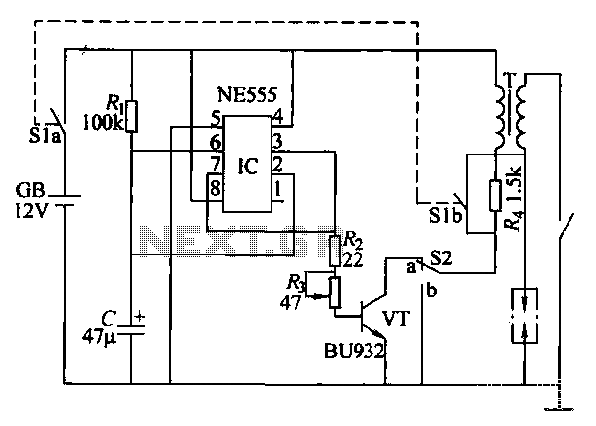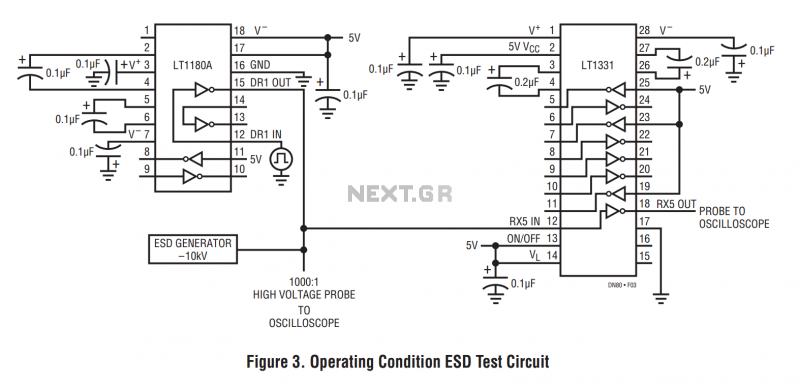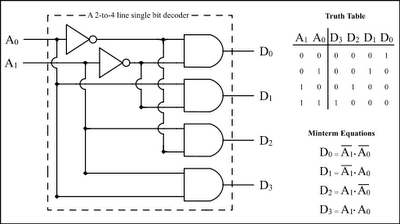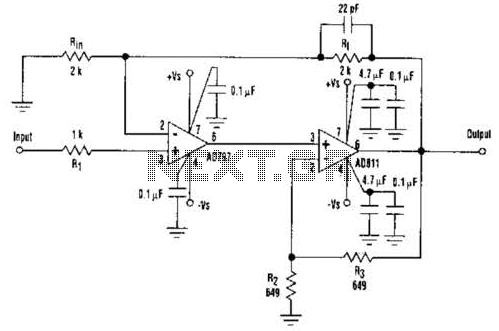
fet amp circuit
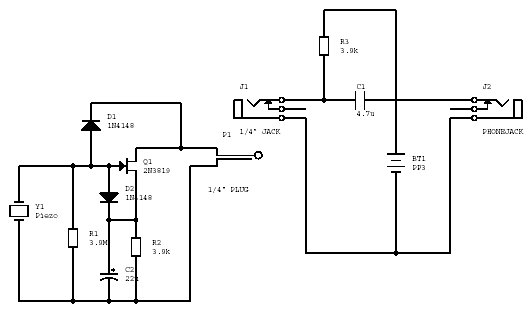
The gate-source voltage required to bias the transistor into the linear region can range from 0.25V to 8V, resulting in a potential variation of 7.75V down to a minimal 0.4V for the transistor and load when used with a typical NiCad 8.4V PP3 battery. It is advisable to acquire more FETs than necessary to discard those that do not meet specifications. Testing is straightforward, and this parameter remains relatively stable across different devices and is not significantly affected by temperature changes. Design manuals often emphasize this aspect, as selecting FETs can increase costs in mass production scenarios. However, that is not a concern in this context, and it is challenging to manage manufacturing tolerances that can waste over 90% of the battery voltage due to variations without filtering out defective units. Ideally, the FET would operate from a higher power supply voltage, such as two batteries in series, which would necessitate doubling the values of resistors R2 and R3. It would be unfortunate to require two batteries solely due to manufacturers' lack of graded Vgs. A reliable FET can be identified by measuring the voltage at the drain and source in-circuit, with the desired values being approximately 2.5V at the source and 6V at the drain, assuming an 8.4V NiCad PP3.
The circuit in question utilizes a field-effect transistor (FET) that requires precise gate-source voltage (Vgs) to operate effectively within its linear region. The specified Vgs range of 0.25V to 8V indicates a significant variation in performance based on the specific characteristics of the FET used. When paired with an 8.4V NiCad PP3 battery, the operational voltage across the transistor and load can fluctuate dramatically, highlighting the importance of selecting high-quality FETs. The recommendation to purchase additional FETs allows for the elimination of subpar components, ensuring reliable circuit performance.
Temperature stability of the Vgs parameter is crucial for consistent operation. Although variations in temperature can affect electronic components, the FETs in this application are expected to maintain their characteristics, thereby minimizing performance fluctuations. This stability is particularly important in applications where precision is required, as the cost implications of selecting appropriately graded FETs can be a concern in large-scale manufacturing.
To optimize the circuit's performance, utilizing a higher power supply voltage is advised. This approach not only enhances the headroom for the FET but also allows for adjustments to the resistor values, specifically R2 and R3, which would need to be doubled to accommodate the increased voltage. The necessity of two batteries to achieve a suitable operating voltage raises concerns about design efficiency and manufacturing practices, particularly if the FETs are not graded for Vgs.
In practice, verifying the quality of the FET can be accomplished by measuring the drain-source voltage (Vds) and source voltage (Vs) while the circuit is operational. An ideal scenario would yield approximately 2.5V at the source and 6V at the drain, ensuring that the FET operates within its linear region and delivers the expected performance. This measurement is a critical step in the validation process, ensuring that the selected FET meets the design requirements and operates effectively within the specified parameters.The gate-source voltage needed to bias the transistor into the linear region can vary between 0. 25V and 8V, which leaves a good 7. 75V down to a hopeless 0. 4V for the transistor and load if used with a typical NiCad 8. 4V PP3 You`ll have to get more FETs than you need and throw out the dogs. It`s easy enough to test, and this parameter is a given for a particular device it doesn`t age of change greatly with temperature. Design manuals get all sniffy about that sort of thing because selecting FETs obviously adds to the cost if you are mass producing something. That`s not the case here, and there`s just no way to cope with a manufacturing tolerance which can throw more than 90% of the battery voltage away in variations in manufacture without screening the bad `uns.
Ideally you`d run the FET from a higher power supply voltgae, like two batteries in series and perhaps double the values of R2 and R3, but it would be a shame to have to use two batteres just because the manufacturers couldn`t be bothered to grade by Vgs. You can tell if you have a good `un by measuring the voltage at the drain and source of the FET in circuit.
Ideally you would like Vs to be about 2. 5V and Vd to be about 6V (assuming a 8. 4V Nicad PP3) 🔗 External reference
The circuit in question utilizes a field-effect transistor (FET) that requires precise gate-source voltage (Vgs) to operate effectively within its linear region. The specified Vgs range of 0.25V to 8V indicates a significant variation in performance based on the specific characteristics of the FET used. When paired with an 8.4V NiCad PP3 battery, the operational voltage across the transistor and load can fluctuate dramatically, highlighting the importance of selecting high-quality FETs. The recommendation to purchase additional FETs allows for the elimination of subpar components, ensuring reliable circuit performance.
Temperature stability of the Vgs parameter is crucial for consistent operation. Although variations in temperature can affect electronic components, the FETs in this application are expected to maintain their characteristics, thereby minimizing performance fluctuations. This stability is particularly important in applications where precision is required, as the cost implications of selecting appropriately graded FETs can be a concern in large-scale manufacturing.
To optimize the circuit's performance, utilizing a higher power supply voltage is advised. This approach not only enhances the headroom for the FET but also allows for adjustments to the resistor values, specifically R2 and R3, which would need to be doubled to accommodate the increased voltage. The necessity of two batteries to achieve a suitable operating voltage raises concerns about design efficiency and manufacturing practices, particularly if the FETs are not graded for Vgs.
In practice, verifying the quality of the FET can be accomplished by measuring the drain-source voltage (Vds) and source voltage (Vs) while the circuit is operational. An ideal scenario would yield approximately 2.5V at the source and 6V at the drain, ensuring that the FET operates within its linear region and delivers the expected performance. This measurement is a critical step in the validation process, ensuring that the selected FET meets the design requirements and operates effectively within the specified parameters.The gate-source voltage needed to bias the transistor into the linear region can vary between 0. 25V and 8V, which leaves a good 7. 75V down to a hopeless 0. 4V for the transistor and load if used with a typical NiCad 8. 4V PP3 You`ll have to get more FETs than you need and throw out the dogs. It`s easy enough to test, and this parameter is a given for a particular device it doesn`t age of change greatly with temperature. Design manuals get all sniffy about that sort of thing because selecting FETs obviously adds to the cost if you are mass producing something. That`s not the case here, and there`s just no way to cope with a manufacturing tolerance which can throw more than 90% of the battery voltage away in variations in manufacture without screening the bad `uns.
Ideally you`d run the FET from a higher power supply voltgae, like two batteries in series and perhaps double the values of R2 and R3, but it would be a shame to have to use two batteres just because the manufacturers couldn`t be bothered to grade by Vgs. You can tell if you have a good `un by measuring the voltage at the drain and source of the FET in circuit.
Ideally you would like Vs to be about 2. 5V and Vd to be about 6V (assuming a 8. 4V Nicad PP3) 🔗 External reference

